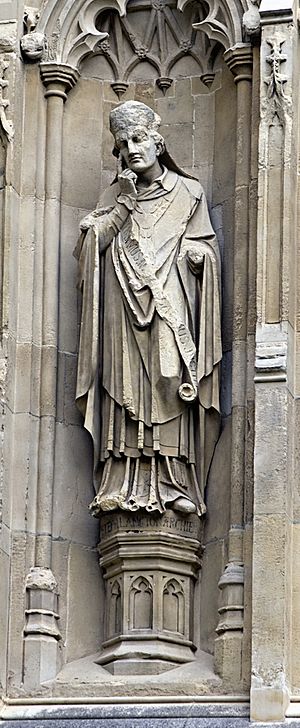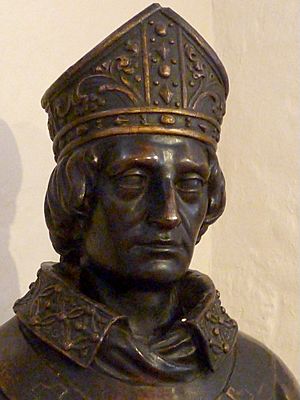Stephen Langton facts for kids
Quick facts for kids Stephen Langton |
|
|---|---|
| Cardinal, Archbishop of Canterbury Primate of All England |
|

Statue of Langton from the exterior of Canterbury Cathedral
|
|
| Appointed | c. 1207 |
| Reign ended | 9 July 1228 |
| Predecessor | John de Gray |
| Successor | Walter d'Eynsham |
| Orders | |
| Consecration | 17 June 1207 by Innocent III |
| Created Cardinal | 1206 |
| Rank | Cardinal priest |
| Personal details | |
| Born | c. 1150 |
| Died | 9 July 1228 Slindon, Sussex |
| Buried | Canterbury Cathedral |
| Nationality | English |
| Denomination | Roman Catholic |
| Parents | Henry Langton |
Stephen Langton (around 1150 – 9 July 1228) was an important English Cardinal and Archbishop of Canterbury. He served in this role from 1207 until his death in 1228. A big disagreement between King John of England and Pope Innocent III about Langton's election led to a major crisis. This crisis helped create the famous Magna Carta in 1215. Stephen Langton is also known for dividing the Bible into the standard chapters we use today.
Contents
Early Life and Education
Stephen Langton was born around 1150. His father was Henry Langton, a landowner in Lincolnshire, England. Stephen likely grew up in a village and went to a local church school. Some stories say he might have been born in Friday Street, Surrey.
He later studied at the University of Paris, which was a very famous university. He taught theology (the study of religious faith) there until 1206. In Paris, he became friends with Pope Innocent III. The Pope then called him to Rome and made him a cardinal-priest. Stephen was known for his strong faith and great knowledge. People saw him as the most important English church leader of his time.
Becoming Archbishop of Canterbury
When the Archbishop of Canterbury, Hubert Walter, died in 1205, choosing a new leader was difficult. Some church leaders chose one person, while King John of England wanted someone else. Both choices were rejected by the Pope in Rome.
So, 16 church leaders went to Rome. The Pope told them to choose a new archbishop. They chose Stephen Langton. The Pope himself made Stephen archbishop on 17 June 1207.
Conflict with King John
This choice led to a big fight between King John and Pope Innocent III. King John was very angry. He said anyone who accepted Stephen as archbishop was an enemy. On 15 July 1207, King John forced the church leaders in Canterbury to leave.
In March 1208, Pope Innocent III took a serious step. He placed England under an interdict. This meant that most church services, like baptisms and burials, could not happen in England. It was a way to pressure the king. When King John still refused to agree, the Pope even tried to remove him as king in 1213.

Langton's Return and Magna Carta
In May 1213, King John finally gave in to the Pope. In July, Stephen Langton and other church leaders who had been forced to leave England were able to return. Before this, Stephen had been living in a monastery in France.
Stephen's first action as archbishop was to forgive King John. The King promised to get rid of unfair laws and respect the freedoms that had been granted by an earlier king, Henry I.
Stephen Langton quickly became a leader against King John. In August 1213, he held a meeting of churchmen and some powerful nobles. There, he read out an old charter (a written agreement) from King Henry I. He asked everyone to renew its promises.
Stephen's strong leadership, along with the military power of the nobles, forced King John to agree to the Magna Carta on 15 June 1215. The Magna Carta was a very important document. It limited the king's power and protected the rights of his subjects.
Later Years and Influence
After the Magna Carta, the Pope supported King John. The Pope even said that the nobles who had forced the king to sign the Magna Carta were no longer part of the church. Stephen Langton refused to announce this. Because of this, he was temporarily suspended from his church duties. He had to stay outside England until peace returned, coming back in May 1218.
Both Pope Innocent and King John died during this time. Everyone in England then supported the new young king, Henry III.
Stephen Langton continued to work for England's independence and rights. In 1223, he again led the nobles. They demanded that King Henry confirm the Magna Carta. Stephen also helped England in its dealings with France. He even got a promise from the new Pope, Honorius III, that no papal representative would be sent to England during his lifetime. This gave the English Church more freedom.

In 1222, Stephen held an important church meeting in Osney. The rules made at this meeting, called the Constitutions of Stephen Langton, are still important in English church law today.
Death and Legacy
Stephen Langton died on 9 July 1228, in Slindon, Sussex. He was buried in the ground next to Canterbury Cathedral. A chapel was later built over his burial spot.
A special walking path, called the "Stephen Langton Trail," was created to celebrate 800 years since the Magna Carta was signed. It starts in his possible birthplace and leads to Lincoln, where an original copy of the Magna Carta is kept.
Stephen Langton's Writings
Stephen Langton wrote many things. He wrote notes, explanations, and studies on almost all the books of the Old Testament in the Bible. He also wrote many sermons. These writings are still kept in libraries at places like Lambeth Palace and the universities of Oxford and Cambridge.
Some people believe that Stephen Langton wrote the famous church song Veni Sancte Spiritus.
Dividing the Bible into Chapters
One of Stephen Langton's most lasting contributions was how he organized the Bible. Before his time, Bible scrolls were divided by blank spaces. But Stephen Langton is believed to be the person who divided the Bible into the standard chapters that we use today.
While another cardinal, Hugo de Sancto Caro, also created a system for dividing the Bible around the same time, it is Stephen Langton's chapter arrangement that is still used around the world.
See also
 In Spanish: Stephen Langton para niños
In Spanish: Stephen Langton para niños

